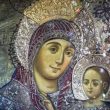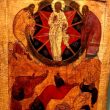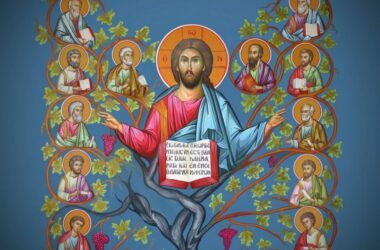On August 15, 1714, in Istanbul (Constantinople), the martyrdom of Holy Voivode Constantin Brâncoveanu took place, marking the day he turned 60 years old. Together with his four sons and counselor Ianache, this event represents a sacrificial fulfillment, a sublime testimony of faith, and a valuable heritage passed down through the centuries. Similar to great builders, his work received the seal of endurance, and his unwavering Christian belief eventually elevated him to the rank of Saints. The nation-building project he envisioned, characterized by cultural development, remained to be continued and perfected by future generations.
The significance of Constantin Brâncoveanu’s legacy has been recognized over time. The Brâncoveanu era has become an integral part of national history, and on June 20, 1992, the Holy Synod of the Romanian Orthodox Church canonized Constantin Brâncoveanu and the other five martyrs who perished 307 years ago. In terms of its political and civilizational message left for future generations, it still represents an aspiration, a subject for reflection, decryption, and a thorough understanding of its significance in the present and, most importantly, in the future. This understanding becomes even more crucial under the pressure of passing time.
Similar to the two great Christian emperors, Constantine and Justinian, whom he admired and whose works inspired his own Romanian endeavor, the martyred voivode rightfully deserves the title of “the Great” due to his Christian sacrifice and enduring cultural contributions.
Christianity as a Foundation and Permanence through Culture
From contemporary accounts and his actions as a ruler, Constantin Brâncoveanu (1688-1714) admired the personalities and structures of individuals such as Constantine the Great and Justinian, both of whom were Christian emperors later recognized as Saints. This fact resonates and offers an explanation regarding his achievements and the ideological legacy he left to posterity. Both of these role models placed Christianity as their foundation and emphasized cultural permanence as a defining characteristic. Additionally, Brâncoveanu’s era stands as a pinnacle of Romanian development up to that point and serves as a new starting point for Romanian progress, unlike any other before it, with enduring perspectives to this day.
It is not by chance, but rather intentionally, that in the Octoechos of 1700, Bishop Mitrofan of Buzău, placing Brâncoveanu’s work in a historical perspective, saw it as the culmination of a chain of development that began with the reign of Matei Basarab (1632-1654), described as having “few and unripe fruits,” which nonetheless served as an initiator. This development continued with the efforts of Șerban Cantacuzino (1678-1688), characterized by “fruits of medium ripeness, neither fully matured nor entirely raw.” Finally, it reached its zenith under Constantin Brâncoveanu, bearing its ripe and sweet fruits, according to the same chronicler’s account.
References to Byzantine emperors and previous rulers imposed a clear sense of continuity and a vision of evolution towards a moment of high synthesis, incorporating elements derived from their own past or borrowed from the post-Byzantine East, Venice, or the Germanic world, assimilated into the local context and spirit. The continuation of prestigious Byzantine traditions and solid national foundations, the maintenance of a perception of the uniqueness and unity of language and faith among Romanians, a clear desire for societal renewal through culture, the demarcation from “others,” and consequently a clearer self-definition, including the effort to present an original image of Europe and a coherent prefiguration of their own beginnings, are the driving forces behind a comprehensive action undertaken and consistently promoted by the ruler.
Indeed, Brâncoveanu’s deep faith and Christian choice set him apart from the Ottomans, and his efforts to promote unity of faith and language among all Romanians through literature and spirituality were defining markers in his relations with the Austrians, Russians, and other nations. His efforts to prevent the division of Transylvanian Romanian Orthodox believers in 1700, which even led to a diplomatic conflict with Vienna, express the same political doctrine of the pursued program. Similarly, the uniqueness and universality of Christianity and the Roman Empire, unmistakable values of the two great emperors who served as his models and inspirations for thought and action – Constantine and Justinian – and the call and encouragement to create a lasting society through culture, respectful of traditions, open to the universal, with aspirations reaching the status of a regional power, became unstoppable in this context. If Justinian embraced the mission to restore Roman greatness guided by the Holy Trinity (as shown in the “Preface” to the Corpus Iuris Civilis), Constantin Brâncoveanu embodied this eternal imperial idea through his deeds and passed it on as a testamentary legacy, emphasizing the primacy of Orthodoxy and its integration in the mission of the Romanian state, which is still embraced today through official national symbols.
Christian attachment, national unity, and affirmation through one’s own culture
Rarely in history, but not by chance, as noted, Romanian cultural manifestations between 1601 (the end of Mihai Viteazul’s reign) and 1821 (Tudor Vladimirescu’s modernizing revolution) have been more significant and enduring than the political and military events that characterized them. The eras of achievement that followed are named after the personalities who promoted them and are defined by at least three dominant landmarks: Christian attachment, aspirations for national unity, and affirmation through one’s own culture, in constant relation to the civilizational horizons of their time.
If Matei Basarab, the founder of such a Romanian historical path, was associated with Vasile Lupu (1634-1653) in Moldavia, the second and more significant wave, culminating for the era, was represented by the works of Șerban Cantacuzino and especially by that of Constantin Brâncoveanu, a ruler described as “Orthodox, with Christian love and zeal” (chronicle), and in Moldavia, particularly through the encyclopedic personality of Prince Dimitrie Cantemir (1710-1711).
Art and beauty associated with the Christian faith
The beginnings of this general work of Romanian reconstruction and affirmation through culture, led by a Basarab from the Brâncovenii Romanațiului lineage, aga Matei, foreshadowed the priority horizons of the endeavor: art and beauty associated with the Christian faith, cultivated through numerous foundations and Christian religious decorations, printing of books, predominantly with religious content, but also with a pronounced normative character, disseminated throughout the entire territory inhabited by Romanians and beyond, the desire for prestige derived from assumed traditions, and aspirations to establish oneself in the regional and European world to which they belonged.
Now, the first Romanian laws or statutes appear, with the beginning represented by the Govora Code (1640), a nomocanon with elements of church law and secular law, intended for Wallachia and the Romanian population in Transylvania. Both editions included prefaces by the Orthodox metropolitans from the two Romanian regions, considered the first attempt at national legislative unification. This was followed by a second attempt of this kind through Vasile Lupu’s code, the Romanian Book of Teaching from Imperial Statutes and Other Districts (1652), which was almost entirely adopted by Matei Basarab in his Îndreptarea Legii (1652), this time among Romanians on both sides of the Milcov River. In the pursuit of such visions and efforts, Șerban Cantacuzino and especially Constantin Brâncoveanu continued their actions, with their central project being the Bible of Bucharest (1688) and a complex of cultural initiatives started and supported from the capital of Wallachia towards the entire Christian horizon influenced by Greek culture. But his greatest merit lies in the fact that he imposed the idea of development through culture and promoted a model of progress on this path that proved suitable for the country. It initially ensured internal prosperity and external balance for a quarter of a century, and most importantly, it foreshadowed a unique project of becoming an affirmation in history, which still holds its significance today.
Faith and culture
307 years after the martyrdom of the Brâncoveanu family, their spiritual legacy left to posterity over the centuries is more relevant than ever, primarily through the resonances of the project of development through faith and culture that they prefigured and consistently promoted. Many of the socio-national aspirations formulated at that time, the Christian beliefs affirmed, and the creative value options assumed can still serve as references for determining priorities and establishing objectives for present and future development.
Perhaps from such a perspective, the work of the Brâncoveanu era should be analyzed especially in-depth and known as fully as possible in its content and significance to be properly valued. Of course, for each historical period, its truths have been received and, according to circumstances and possibilities, fulfilled. The cultural and spiritual unity promoted at that time ultimately materialized in the political and state realm through the acts of union in 1859 and 1918. The Christian Orthodox religion has been preserved and flourished throughout the Romanian territory, and its Church, the “mother” of our people since time immemorial, is now the guardian and cultivator of national moral and Christian values. The Romanian language of the “old sermons” has modernized and evolved, fulfilling its role as a means of communication and, in particular, as a treasure for preserving and expressing the specifics and richness of its own identity. Finally, the Romanian book has experienced times of glory and is now undergoing the transformations of digitization, but without losing the memory and essence imprinted over hundreds of years, serving as a shield against forced uniformity and as a means of knowledge and expression of national identity in the face of global homogenization.
This valorization of the Brâncoveanu heritage has now reached the time for synthesis and distillation at the level of a development model through culture, validated by history and imposed by the general situation marked by European integration, economic globalization, and digital interconnection.
To better grasp the outline of the project and express its content, an effort of understanding and acceptance is needed, in the name of the opportunity that was once the motto for our rulers to be what we used to be and even more.
A duty and an opportunity
The idea and initiative behind such an endeavor start, not by chance, from the “Saint George” Church in Bucharest, a foundation and sanctuary of the relics of the Holy Voivode, located at the 0 kilometer mark of today’s Romania. Continuing the Brâncoveanu traditions and valorizing them until prefiguring, on this basis and in such a context, a national project also become a duty and an opportunity for today’s generations. The modest beginnings of our action can consist mainly in creating a framework for information and knowledge, through the publication of fundamental works on the Brâncoveanu legacy, such as the two conferences of Nicolae Iorga in 1914 (on August 14 regarding the political value and on September 12 regarding the cultural activity of Constantin Brâncoveanu and the goals of the Romanian Academy) and a series of lectures on themes and with appropriate approaches to the contemporary reading of the Brâncoveanu message, in order to extract and valorize his ideas. In this way, the dimensions of a representative historical monograph of Constantin Brâncoveanu’s reign and achievements can be distilled and fulfilled, integrated into the era he generated and with the reverberations that remain in history, which we still owe him. From the pulpit of the Brâncoveanu foundation in the center of Romania, through the contributions of personalities of national culture, university professors, members of the Romanian Academy, scientific researchers, and other specialists, the Brâncoveanu message of development through culture will be brought to the present and expressed in its essential dimensions, so as to become an equal impetus for creative thinking and constructive founding activity.
University prof.dr Mircea Duțu, Rev Dr. Emil Nedelea Cărămizaru
Source: http://ziarullumina.ro.
Dictionary:
Brâncovenii Romanațiului – the region where the Brankovians descendants came from
aga –office clerk
Îndreptarea Legii – Straightening the Law






